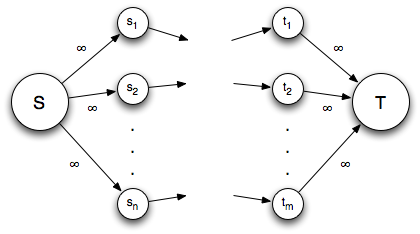The last type of graph problem we will investigate is maximum flow problems. Intuitively, these problems can be thought of as starting with a source faucet that can provide as much water as possible. The faucet is connected to a sink drain that can handle any amount of water through a network of pipes. The pipes are of different sizes, i.e. have different capacities which limit the flow through certain branches of the network. The problem is to determine what is the maximal flow, i.e. the most water, that can travel through the network from the faucet to the drain.
Maximum Flow
We shall now formalize the maximum flow problem in graph terms, state some key definitions for network flows, and prove a very important theorem that will serve as the foundation for the algorithms.
Given a flow network G(V, E) which is a connected, directed graph with each edge (u,v) having a capacity c(u,v) ≥ 0 (assuming c(u,v) = 0 if (u,v) ∉ E), a source vertex s, and a sink vertex t: a flow is a function between all pairs of vertices that satisfies
- f(u,v) ≤ c(u,v) for all u,v (capacity constraint)
- f(u,v) = -f(v,u) for all u,v (skew-symmetry)
- Σ f(u,v) = 0 for all u,v except s,t (flow conservation, i.e. flow in = flow out)
The value of a flow is defined as
which is the total amount out of the source (which by flow conservation must also equal the total amount into the sink).
Problem
Given G, s, and t find the maximal flow value.
Multiple Source/Sinks
The problem of multiple sources and/or sinks can be easily recast as a single source, single sink problem by creating “super” source and sink nodes with edges of infinite capacity between the “super” nodes and the network source/sinks as illustrated below.
Residual Networks
A residual network is an induced graph that contains edges that can admit more flow, i.e. the edges that are not at capacity. The residual capacity of any edge is given by
Thus the residual network consists of the edges for which cf(u,v) > 0. Note that as flow is increased along edges in the original graph, reverse edges need to be added to the residual network in the opposite direction. This will allow for “decreasing” the flow along an edge in the original network.
Augmenting Paths
An augmenting path is a simple path from s ↝ t in the residual network. In other words it is an entire path which can admit additional flow from the source to the sink (all edges along the path have residual capacity). The residual capacity of an augmenting path is the maximum amount of additional flow that can be admitted along an augmenting path - which is limited by the edge with minimum residual capacity.
Cuts
A cut is a partition of V into sets S and T such that s ∈ S and T = V - S has t ∈ T. This is similar to MST cuts except that the source must be in one partition and the sink in the other partition (and the graph is directed).
The net flow across the cut is f(S,T) and the capacity of the cut is c(S,T).
A minimum cut is a cut with minimum capacity. It can be shown that the net flow across any cut is equal to the total flow of the network (again by flow conservation), and furthermore the value of any flow is upper bounded by the capacity of any cut.
Max-flow Min-cut Theorem
Using the above definitions, the following theorem can be proven:
If f is a flow in a network G with source s and sink t, then the following three statements are equivalent:
- f is a maximum flow in G (with value |f *|)
- The residual network contains no augmenting paths.
- |f | = c(S,T) for some cut (S,T) of G
Generic Maximum Flow Algorithm
By the max-flow, min-cut theorem, a maximal flow can be found by continually augmenting flow along paths with residual capacity, i.e.
1. Initialize f to 0 2. while there exists an augmenting path p 3. augment the flow along p by the residual capacity cf(p)
While this algorithm is not particularly useful for implementation, we can observe that for integer capacities the algorithm runs in O(E|f *|) since each iteration checks at most E edges (e.g. BFS) and increases the flow by at least 1.




